While all 50 states in the United States have official state animal symbols, many take it even further by adopting official animals of different classifications. Kansas has eight official state animal symbols. Granted, two of them lived over 80 million years ago, but those prehistoric animals are just as much official symbols of the Sunflower State as all the others.

1. State Animal: American Bison
The American bison (Bison bison) was adopted as Kansas’ official animal symbol in 1955. It is listed as the American buffalo in the official state record, but bison is the more scientifically accurate nomenclature. The term “buffalo” is believed to be derived from the French word for beef, “boeuf.”
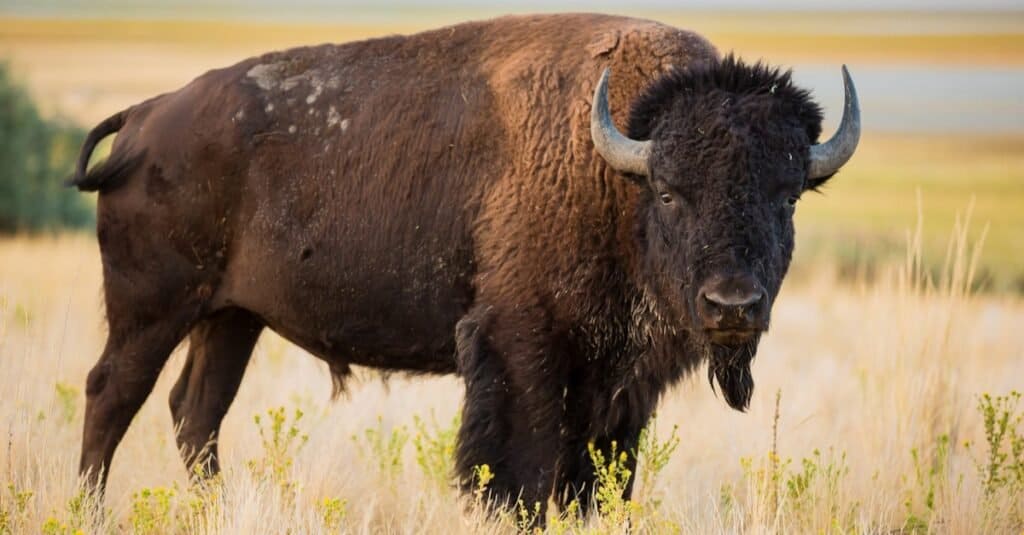
American Bison are the largest land mammal in North America.
©O.S. Fisher/Shutterstock.com
The Kanas state flag and state seal depict Native American hunters pursuing a herd of bison. The bison is also featured on the commemorative Kansas state quarter released by the U.S. Mint on August 29, 2005.
Along with Kansas, the bison is also the state animal symbol of Oklahoma and Wyoming. In 2016, the bison was designated as the national mammal of the United States.
The bison is the largest land animal in North America. A bull can weigh up to 2,000 pounds and stand six feet tall, while a cow can weigh 1,000 pounds and reach a height of five feet.
They were critical to indigenous peoples as well as settlers. The plains bison’s range once covered much of the continental United States, but overhunting decimated the population. Bison were on the verge of extinction, but thankfully conservation and relocation efforts have helped this American icon mount a comeback.
Kansas boasts the fifth-largest bison population in the United States today. While many of them are on ranches, the Maxwell Wildlife Refuge near Canton has the state’s largest public herd with 200 bison.
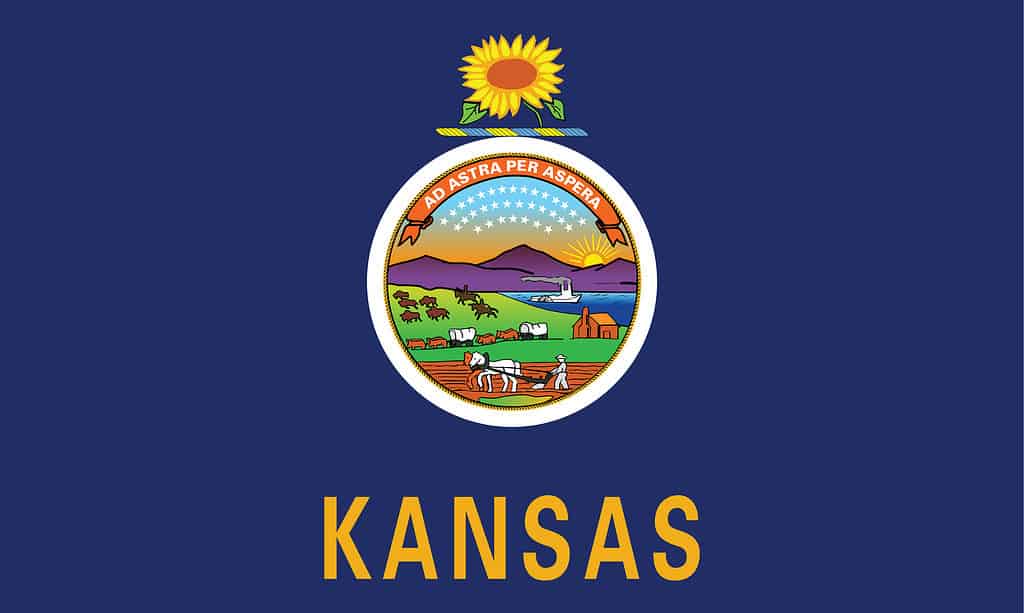
The Kanas state flag and state seal depict Native American hunters pursuing a bison herd.
©iStock.com/bodrumsurf
2. State Bird: Western Meadowlark
The Western Meadowlark (Sturnella neglecta) became Kansas’ first official animal when it was designated the state bird in 1937. Along with Kansas, the Western Meadowlark is also the state bird in Montana, Nebraska, North Dakota, Oregon, and Wyoming. Only the Northern Cardinal is the official avian symbol in more states with seven. Together, the Western Meadowlark and the Northern Cardinal are the official birds in more than one-quarter of all U.S. states.
The Western Meadowlark looks very similar to its close relative, the Eastern Meadowlark. Meriwether Lewis, of the famed Lewis and Clark Expedition, was the first to note the differences between the two birds.
The Western Meadowlark is a migratory bird with a medium migration range stretching from Canada to Mexico. While the northern and southernmost reaches of the bird’s range are seasonal, Kansas residents can observe these birds virtually any time of the year.
The Western Meadowlark is a common sight across the western two-thirds of the continental United States. It is often seen perched on fenceposts and in open country. One of the most recognizable songbirds in the western U.S., the Western Meadowlark’s flute-like song is an iconic symbol of the plains and grasslands.
A statewide poll of Kansas schoolchildren was taken in 1925 to select the official bird for the state. The Western Meadowlark received nearly 125,000 votes. Second and third places went to the Bobwhite Quail and Northern Cardinal, respectively.
After the children of Kansas made their voices heard, it took 12 years for legislators to act. But in 1937, the Western Meadowlark was officially named the first-ever state animal of Kansas.
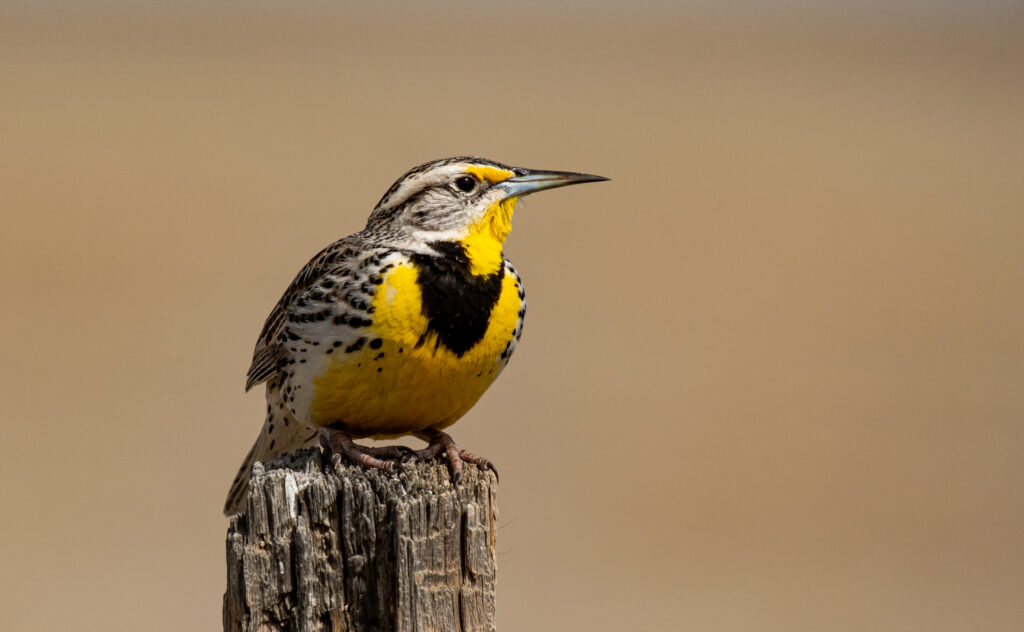
Western Meadowlarks can be seen perched on Kansas fence posts.
©Kerry Hargrove/Shutterstock.com
3. State Insect: Honey Bee
Kansas’ state insect is another instance where the voices of the state’s schoolchildren were heard. In 1976, state legislators responded to a petition signed by thousands of Kansas children who advocated for the designation of the honey bee (Apis spp.) as the official insect of the state.
A portion of Kansas House Bill 2236, making the designation official, states, “The honey bee is like all Kansans in that it is proud; only fights in defense of something it cherishes; is a friendly bundle of energy; is always helping others throughout its lifetime; is a strong, hard worker with limitless abilities; and is a mirror of virtue, triumph, and glory.”
The western honey bee (Apis mellifera) is easily the most widespread of the eight honey bee species. It is found in most of the world’s ecosystems, except for the most extreme climates. Humans rely on honey bees for much more than just delicious honey. They pollinate many fruits, vegetables, and nuts that are staples of our diet.

Honey bee pollination is vital for agriculture.
©Samo Trebizan/Shutterstock.com
A Popular State Insect
The honey bee population numbers have declined due to disease, habitat loss, and pesticide exposure. As a result, many have sought to raise awareness so the bees will be better protected, including several states that have named the bee their official state insect.
Along with Kansas, the honey bee is the state insect of Arkansas, Georgia (along with the tiger swallowtail butterfly), Louisiana, Maine, Mississippi (along with the spicebush swallowtail butterfly), Missouri, Nebraska, New Jersey, North Carolina, Oklahoma (along with the black swallowtail butterfly), South Dakota, Tennessee (the honey bee is the official state agricultural insect), Utah, Vermont (along with the monarch butterfly), West Virginia, and Wisconsin. With 17 states, the honey bee is the most popular state insect in the United States by a wide margin.
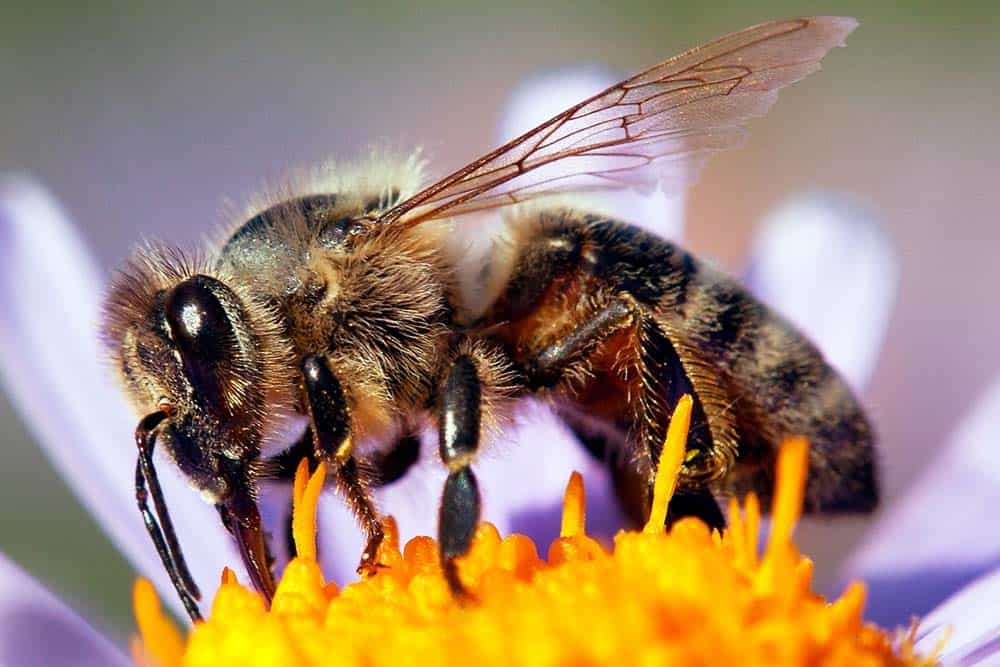
The honey bee is the state insect in 15 U.S. states.
©Daniel Prudek/Shutterstock.com
4. State Reptile: Ornate Box Turtle
The designation of Kansas’ state reptile is yet another that originated in a Kansas elementary school. A sixth-grade class in Caldwell nominated the ornate box turtle (Terrapene ornata) as the official state reptile. Kansas legislators made it official in 1986.
Kansas was the only state to feature the ornate box turtle as its official state reptile until Nebraska made the same declaration in 2022. The turtle’s close relative, the eastern box turtle, is the state reptile of North Carolina and Tennessee.
Unlike most other turtles, the ornate box turtle is primarily a grassland and prairie reptile rather than dwelling near water. Its range extends throughout the Great Plains.
These turtles are most often found in grasslands that provide some access to water. They also seek out a soil consistency that allows them to burrow for the winter and also allows females to nest.
The turtle’s ornate shell coloration gave rise to its name. The shell features a colorful striped pattern of yellow, black, and red. Ornate turtles are a small turtle species, only measuring around six inches long when fully grown.
The turtle’s small size and colorful shell have prompted many to take the turtle as a pet. After all, it is a box turtle, so why not box it up and take it home, right? Well, for starters, it is illegal. Taking turtles from the wild to keep as pets is against the law in Kansas.
The ornate box turtle is classified as a Near Threatened species. The segmentation and development of prairie land are some of the greatest threats to the ornate box turtle population. Taking them out of the wild as pets only adds to the problem.

The ornate box turtle’s name refers to the ornate coloration of its shell.
©Matt Jeppson/Shutterstock.com
5. State Amphibian: Barred Tiger Salamander
The barred tiger salamander (Ambystoma mavortium), sometimes known as the western tiger salamander, was named the state amphibian of Kansas in 1994.
Tiger salamanders were once thought to be a single species with multiple subspecies. Genetic analysis has since shown significant differences, and many of the subspecies represent a distinct species. The barred tiger salamander is now classified as its own species, with several subspecies.
This salamander’s range extends throughout the western United States, southwestern Canada, and northern Mexico. As juveniles, these amphibians are exclusively aquatic and are equipped with gills. When mature, they can be found in woodlands and grasslands close to ponds, lakes, or streams.
This species can grow up to 14 inches long, which is quite large for a salamander. Many salamanders only measure around six inches when fully grown.
The barred tiger salamander is largely nocturnal and is an opportunistic feeder. It is not a picky eater, consuming anything from insects, frogs, snails, slugs, worms, fish, and other salamanders. If no other prey is available, it will even cannibalize members of its own species. This salamander is cold-blooded in more ways than one!
Colorado joined Kansas in 2012 as the only other state to adopt this species as its official state amphibian.
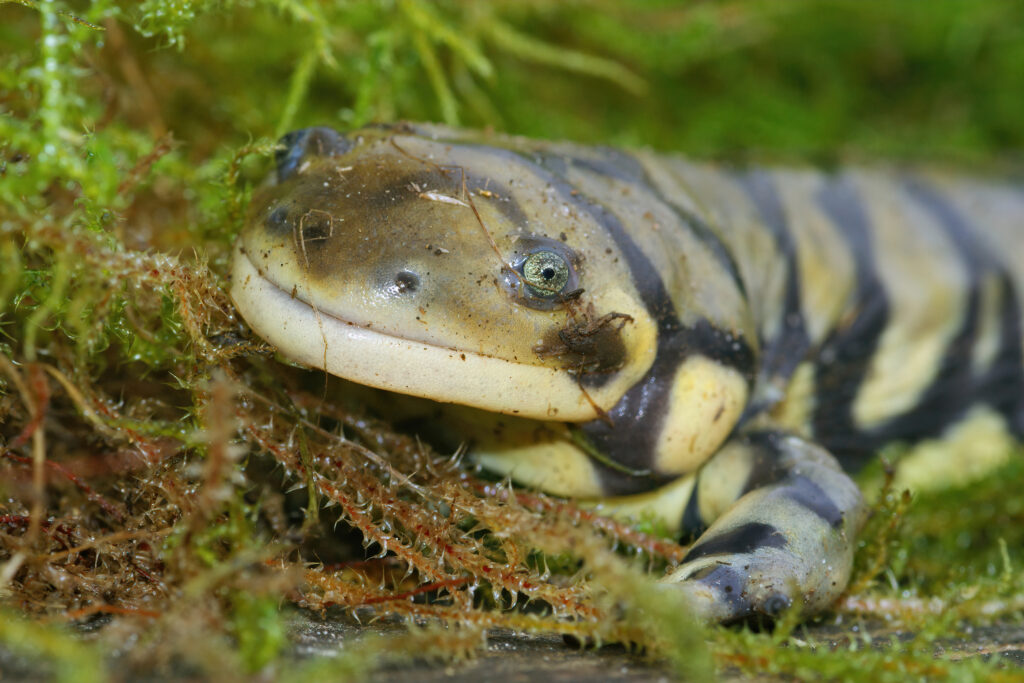
The barred tiger salamander can be found throughout Kansas near bodies of water.
©iStock.com/Wirestock
6. State Fish: Channel Catfish
Legislators named the channel catfish the state fish of Kansas in 2018.
Santor Anthony Hensley (D) called the designation “long overdue,” stating he recalled discussions about this legislation as far back as the 1980s. Sen. Dennis Pyle (R) jokingly quipped that the channel catfish must have “nine lives.”
It may have taken a while, but the channel catfish has secured its place as an official state symbol in Kansas. The fish is native to Kansas waters and is a primary target for the state’s anglers. In fact, the Kansas Department of Wildlife and Parks calls the channel catfish “the bread and butter of Kansas fishing.”
The fish is found in rivers, lakes, reservoirs, ponds, and streams throughout the state. To maintain Kansas’ position as a top fishery for channel catfish, millions are produced in state hatcheries each year to stock Kansas’ waters.
Channel Catfish Appearence
Channel catfish are brownish-yellow with white bellies. The weight of channel catfish can vary widely depending on a variety of factors, including the water body where it resides, food supply, and competition from other predators. Adult channel catfish can weigh 2-4 pounds, though much larger catfish of 10-15 pounds are often caught by Kansas anglers. The state record is a 38-inch channel catfish that weighed 36.5 pounds. Rick Barnow caught this monster channel catfish in Cherokee County on June 3, 2002.
Channel catfish are among the most frequently caught fish in North America, primarily because they are so accessible. Bank fishing is highly effective, both with trotlines or rod and reel. Because channel catfish aren’t picky eaters, a wide variety of bait selections are available. As with many catfish, a general guideline for bait is if it smells bad to you, channel catfish are likely to love it.

Millions of channel catfish are added to Kansas’ waters each year to preserve the quality of the state’s fisheries.
©Aleron Val/Shutterstock.com
7. State Flying Fossil: Pteranodon
Most states have adopted at least one state fossil. While these animals lived millions of years ago, they are still recognized as state symbols in 44 states. And why not? These animals called these states home long before humans did. The only states without an official state fossil are Hawaii, Indiana, Iowa, Minnesota, New Hampshire, and Rhode Island.
The Pteranodon (Pteranodon longiceps) was named the official state flying fossil of Kansas on April 9, 2014. On that date, Statute 73-3401 was passed, stating, “Pteranodon, a great, winged pterosaur with a wingspread of more than 24 feet, which flew the skies of Kansas during the Cretaceous Period of the Mesozoic Era, is hereby designated as the official flying fossil of the state of Kansas.”

Many Pteranodon fossils have been found in Kansas.
©Captain Wang/Shutterstock.com
Is It a Dinosaur?
The Pteranodon isn’t actually a dinosaur. Instead, it was part of a group of flying reptiles known as pterosaurs. These creatures are often depicted with sharp, menacing teeth, but that’s another misconception. They were actually toothless. In fact, the name “Pteranodon” means “wing with no teeth.”
Pteranodons lived during the late Cretaceous Period, which was 83+ million years ago. During that time, Kansas was covered by a shallow sea called the Western Interior Seaway.
Most of the Pteranodon fossils found in Kansas have come from the Smoky Hill Chalk of western Kansas. These massive flying reptiles were likely either feeding on sea creatures or migrating across the sea. Despite its massive size, this winged predator’s diet was largely made up of fish. Paleontologists believe the Pteranodon would swoop down and dip its long beak into the water. It would then skim the water’s surface until its quarry was caught in its jaws.
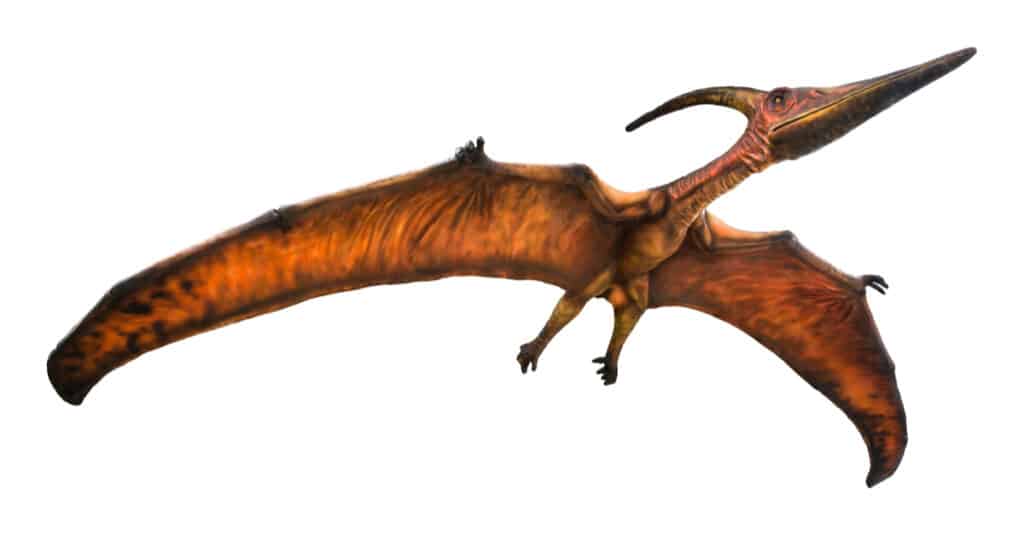
The Pteranodon was part of a group of flying reptiles known as pterosaurs.
©YuRi Photolife/Shutterstock.com
8. State Marine Fossil: Tylosaurus
Kansas legislators named two official state fossils in 2014. On the same day the Pteranodon was named the state’s official flying fossil, the Tylosaurus (Tylosaurus kansasensis) was designated Kansas’ official marine fossil.
Statute 73-3301 reads, “Tylosaurus, a giant Mosasaur which inhabited the great inland sea that covered portions of Kansas during the Cretaceous Period of the Mesozoic Era and grew to lengths of more than 40 feet, is hereby designated as the official marine fossil of the state of Kansas.”
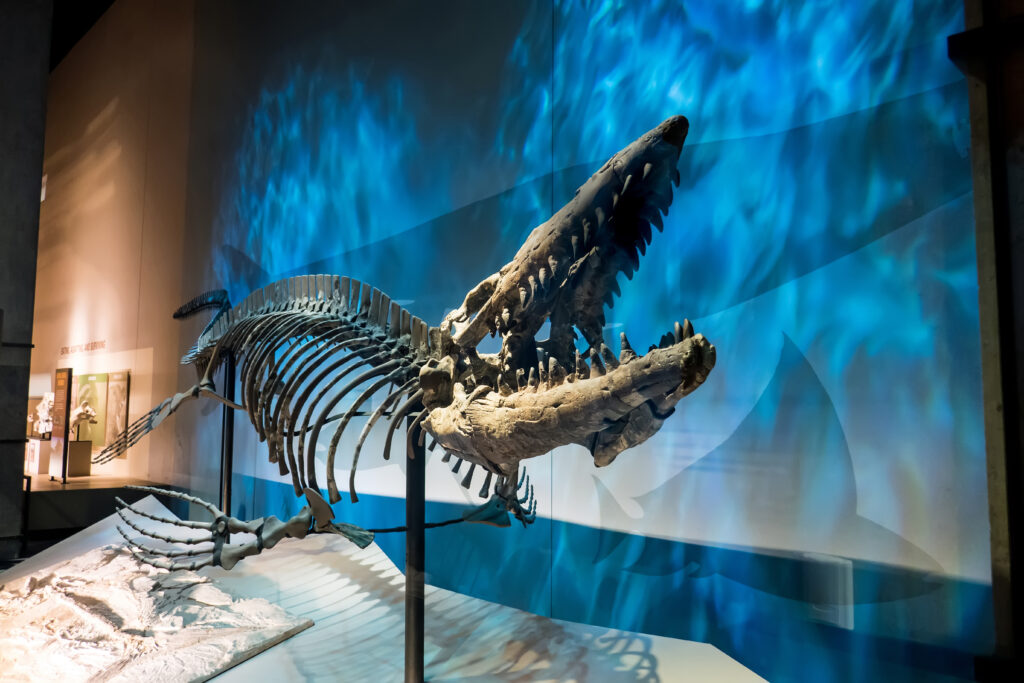
A Tylosaurus skeleton is in the permanent collection at the Perot Museum of Nature and Science in Dallas, Texas.
©William Cushman/Shutterstock.com
Is It a Dinosaur?
Just like Kansas’ other state fossils, this creature is often mislabeled as a dinosaur. It was not a dinosaur but rather a Mosasaur that lived during the late Cretaceous Period, the same time as the Pteranodon. This prehistoric marine predator is closely related to modern monitor lizards and snakes.
This Tylosaurus hunted the Western Interior Seaway that covered the land we know today as Kansas. Its name means “large protuberance,” referring to its elongated snout.
The Tylosaurus measured over 50 feet long and weighed over 1,000 pounds. This ancient apex predator featured sharp teeth and a deadly bite. One study suggested that the Tylosaurus had the most powerful bite force of any animal that ever lived, with an estimated force of 8,000 PSI! That is more than twice the bite force of the saltwater crocodile, which features the most powerful bite of any animal today.
Kansas seems to be the Tylosaurus capital. Many of its fossils have been found in the state, the first of which was discovered in 1868 in Gove County. In fact, the Kansas fossils are now classified as a distinct species, which is reflected in its scientific name Tylosaurus kansasensis.
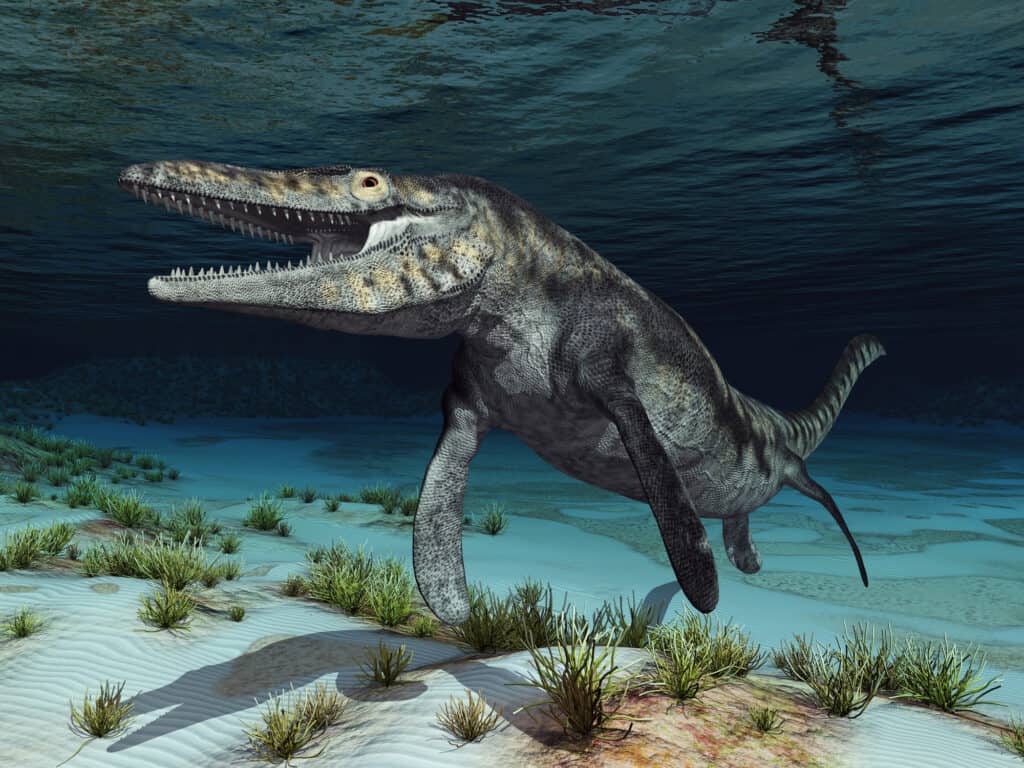
The Tylosaurus hunted the sea that once covered Kansas.
©iStock.com/MR1805
The photo featured at the top of this post is © iStock.com/Wirestock
Thank you for reading! Have some feedback for us? Contact the AZ Animals editorial team.






